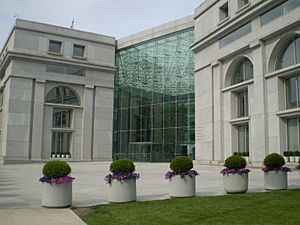Federal Judicial Center facts for kids
The Federal Judicial Center is like a special school and research center for the United States federal courts. It helps judges and court staff learn and do their jobs better. A law passed by Congress in 1967 created it. The idea for this center came from a group of judges called the Judicial Conference of the United States.
The Center's main jobs are:
- Teaching new and experienced federal judges and court employees.
- Giving advice on how the federal courts should work.
- Doing research on how federal courts operate and their history.
The law decides who serves on the Center's Board of Directors. The Chief Justice of the United States is always the head of the board because of their position. The board also includes the director of the Administrative Office of the United States Courts and seven judges chosen by the Judicial Conference. This board picks the Center's director and deputy director. The director then hires the rest of the staff. Since 1967, the Center has had ten directors. Judge Jeremy Fogel became director in 2011. The deputy director is John S. Cooke.
Contents
How the Center Started
Chief Justice Earl Warren and other judges wanted a separate group to do research and teach programs for the federal courts. They hoped this new group would help the courts be more independent. They asked Congress to create the Federal Judicial Center. They believed that regular research and education would make the federal courts work better. This would also help clear up the many cases waiting in the lower courts.
The Center is managed by its own board. It offers the courts independent social science research and educational programs. These programs are designed to improve how courts are managed.
In the 1950s and early 1960s, the Judicial Conference and the Administrative Office often asked for research projects. These projects looked at problems in court management. At the same time, they set up training programs to help judges handle more and more complex cases. However, these research and education programs did not have permanent staff or money.
Support for a permanent program of judicial research and education grew. This happened after adding 60 new district judge positions in 1961. It showed that simply having more judges would not solve all the problems of busy courts. Many judges and lawyers then asked for a way to bring better research and education to the courts.
The Center has several different offices and groups that help it do its work.
Director's Office
The Director's Office manages the entire Center. It also handles the Center's relationships with other organizations. Its Office of Systems Innovation and Development (OSID) gives technical help for the Center's education and research. The Communications Policy and Design (CPD) team edits and shares all the Center's printed and online materials. They also run the Federal Judicial Television Network. Through the Information Services Office, they keep a library of materials about how courts are managed.
Research Division
The Research Division studies how federal courts work. They look at court management and how punishments are decided. They often do this research when asked by the Judicial Conference, the courts themselves, or other groups in the federal system. James B. Eaglin is the current director of the research division.
Federal Judicial History Office
The Federal Judicial History Office creates programs about the history of the judicial branch. It also helps courts with their own history programs.
Education Division
The Education Division holds training sessions for federal judges and court staff. Bruce Clarke is the current director of the Education Division.
Interjudicial Affairs Office
The Interjudicial Affairs Office shares information about federal courts with officials from other countries' court systems. It also gathers information about foreign court systems. This helps the Center with its other jobs.
Board of the Center
The Center's board members are:
- John G. Roberts, Jr., Chief Justice of the United States, who is the chair.
- Judge Susan H. Black, from the U.S. Court of Appeals for the Eleventh Circuit.
- Judge David O. Carter, from the U.S. District Court for the Central District of California.
- Magistrate Judge Karen Klein, from the U.S. District Court for the District of North Dakota.
- Judge Loretta A. Preska, from the U.S. District Court for the Southern District of New York.
- Judge Philip Martin Pro, from the U.S. District Court for the District of Nevada.
- Judge Stephen Raslavich, from the U.S. Bankruptcy Court for the Eastern District of Pennsylvania.
- Judge William B. Traxler Jr., from the U.S. Court of Appeals for the Fourth Circuit.
- James C. Duff, Director of the Administrative Office of the U.S. Courts.
A nonprofit organization called the Federal Judicial Center Foundation helps raise money for the Center.


